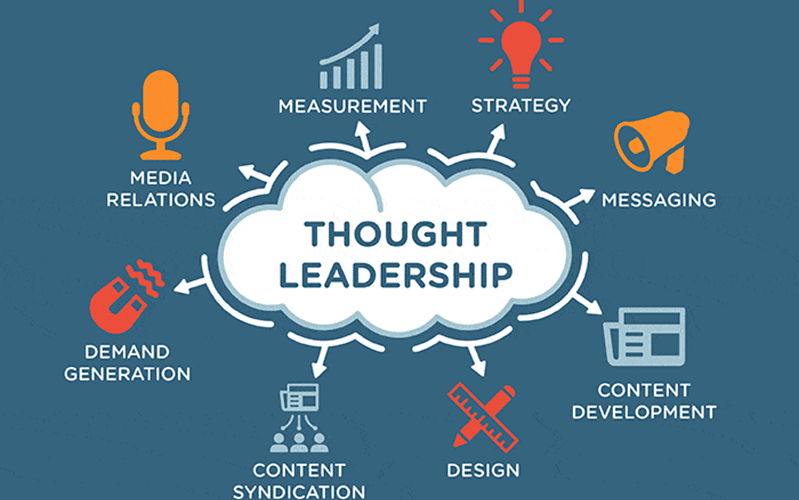Creating successful thought leadership content may help you elevate your brand, establish yourself as an industry authority, and build trust with your target audience. The first time I stepped into thought leadership content, it felt like I was exploring unfamiliar ground. But with a clear approach and some trial and error, I figured out what works and what doesn’t. Creating compelling thought leadership content involves more than just expertise; it necessitates a purposeful approach that connects with your audience and meets their needs. In this comprehensive guide, we’ll discuss what thought leadership content is, why it’s important, and how to effectively generate it.
What is a Thought Leadership Content?
Thought leadership content is developed to communicate insights, ideas, and opinions that establish an individual or organization as an expert in a particular topic. This type of content goes beyond basic facts, providing fresh perspectives, new solutions, and in-depth research that can affect industry trends and educate decision-making.
Who are the Thought Leaders?
According to Orbit Media’s research, the best thought leaders are considered experts in their subject. These professionals could include CEOs, consultants, authors, coaches, and businesses (both B2C and B2B).
Thought leaders frequently have;
- Strong viewpoints
- Experience
- Knowledge
- Transparency
- A desire to share their knowledge with others.
- Ability to think outside the box
Much of the thought leadership I encounter is quite weak, with writers failing to give real nuggets, recommendations, and actionable insights. True thought leaders are constantly ahead of the curve and should not be concerned with giving away too much.
Overall, thought leaders want to freely share knowledge, leveraging firm resources and data to back up their viewpoints and skills.
Why Is Thought Leadership Important?
Thought leadership promotes credibility and trust, both of which are necessary for acquiring new clients, partners, and prospects. Here are some major reasons why thought leadership is important:
- Increases Authority: Positions you or your company as a leading voice in your industry.
- Fosters Trust: Establishes a sense of dependability and knowledge, making it easier for your audience to believe your thoughts and recommendations.
- Enhances Visibility: Increases your market presence, allowing you to reach a larger audience.
- Drives Engagement: Provides your audience with relevant and informative content to develop deeper connections.
- Influences Decisions: Sets industry trends and influences your audience’s decision-making process.
When Should You Use Thought Leadership Content?
Thought leadership, like most types of content, is not appropriate in all circumstances. Here are three company goals that are ideal for this type of content.
#1. Increase trust and credibility
Thought leadership content boosts brand awareness by instilling trust and credibility in your target audience.
Expert content is immediately identifiable and well-valued by industry peers. Your audience relies on you for tried-and-true content, and they can be confident that there are no “ulterior motives” because you are not attempting to sell them anything.
Once the benefits of thought leadership begin to accrue, they multiply rapidly. They can benefit a brand for years because the content is quoted in other industry blogs and alluded to in social media content, reinforcing your reputation as a topic expert.
#2. Connect with your audience
Thought leadership content helps you connect with your audience, especially when you put a face to the authors. People who trust brands are more likely to create human-to-human ties.
Make your organization more approachable by generating content that incorporates your founder’s and staff members’ knowledge. When clients see bylined content from internal sources, they are more likely to link their expertise with your company. They will see your founder or team members as someone who can provide solutions to their problems.
#3. Address industry themes that are not SEO keyword-based.
As much as we value the importance of SEO, low keyword traffic does not inevitably imply that your chosen topic lacks an audience.
Thought leadership content is ideal for exploring such themes. After all, 71% of decision-makers read thought leadership pieces to help them generate fresh ideas, not to locate another post on too complex SEO problems.
Steps for Creating Effective Thought Leadership Content
Step #1: Understand Your Audience
To generate interesting thought leadership content, you must first understand your target audience’s needs, concerns, and interests. This entails looking beyond basic demographics and delving into psychographics and behavioral trends.
Why Does This Matter:
- According to LinkedIn B2B Institute, 77% of B2B marketers believe that their organization’s success in thought leadership is primarily based on a thorough understanding of their target audience.
- Content that speaks to the audience’s individual concerns and interests might result in three times higher engagement (Content Marketing Institute).
When I began focusing on my audience’s pain concerns, the engagement of my articles increased dramatically. I wasn’t simply creating content; I was also solving real-world problems.
Step #2: Offer Unique Insights and Perspectives
Your thought leadership content should provide something unique that distinguishes you from the crowd. This entails discussing your personal experiences, industry insights, and unique ideas.
Why Does This Matter:
- According to the Edelman-LinkedIn Thought Leadership Impact Study, 71% of B2B decision-makers prefer to engage with brands that offer distinctive insights and appealing points of view.
- Content with original research or unique insights is seen as more reliable and authoritative (Demand Generation Report).
Sharing my actual experiences and lessons learned proved to be more effective with my audience than merely regurgitating industry trends. For example, my post on overcoming digital marketing obstacles was widely praised for its practical, real-world recommendations.
Step #3: Be Authentic and Transparent
Authenticity is essential for developing trust with your audience. Be open about your accomplishments and failings, and avoid overly promotional content.
Why Does This Matter:
- 90% of people believe authenticity is vital when determining which brands to like and support (Stackla).
- Authentic content can increase engagement by 30% above promotional content (Hootsuite).
In one of my posts, I freely shared a disastrous marketing strategy and the lessons we learned. The sincerity of the piece resulted in improved trust and closer ties with my readers.
Step #4: Apply Data and Research
Use good evidence and study to back up your conclusions. This not only increases credibility but also aids in the development of a compelling argument.
Why Does This Matter:
- According to Forrester, 85% of B2B marketers believe that developing powerful thought leadership content requires high-quality, precise data.
- Articles containing data-driven insights are 58% more likely to be shared (BuzzSumo).
In my writing, I constantly use pertinent statistics and data to back up my claims. Citing research on the efficiency of various marketing methods, for example, strengthened my recommendations and improved the legitimacy of my content.
Step #5: Engage With Your Audience
Thought leadership is more than just providing content; it’s about starting conversations. Engage with your audience via comments, social media, and other interactive channels.
Why Does This Matter:
- 60% of thought leadership content providers that regularly engage with their audience report increased trust and loyalty (LinkedIn B2B Institute).
- Interactive content creates twice as much interaction as static content (Demand Metric).
I observed a huge increase in engagement after I began actively replying to comments and participating in discussions prompted by my content. This two-way communication fosters relationships while also providing valuable input.
How to Develop Thought Leadership Ideas
The best thought leadership ideas arise in reaction to real-world situations. The true hurdle here is determining what those difficulties are. But the odd thing is, your organization already has a wealth of market intelligence.
#1. Listen to Sales Calls
Begin by listening to sales calls. With only a few calls, you can easily create pages and pages of real-world problems relevant to your audience. In fact, you will learn about your market’s primary pain areas, organizational ambitions, personal aspirations, and much more.
#2. Use Social Listening
Social listening is more than just tracking hashtags and brand mentions. Take a close look at what others are saying about your business, industry, competitors, etc. See what the mood is and how people are feeling about specific topics and situations.
#3. Use Your Product Analytics
Look at your product’s user data. You’ll discover several unique insights that no one else could have come up with on their own. This information is unique to your firm. As a result, it is an invaluable resource for reports, one-pagers, infographics, and much more.
#4. Conduct surveys with customers and partners.
You can also consult with your customers and partners to see how they view specific issues or trends. Conduct surveys and use the results to create reports, infographics, and other content.
#5. Check Your Competitors
Don’t limit yourself to copying what your competitors are doing. The key to creating thought leadership content is isolation. Examine what your competitors are saying and see if you can provide a better response than them.
7 Thought Leadership Content Examples
#1. Semrush
This Semrush post is an excellent illustration of an instructive one-pager. It may not look like a thought leadership content article, but it is. Useful assets like this assist people (often Semrush’s target market) in learning how to perform things related to their jobs and careers. This dynamic encourages people to see Semrush as the authority on topics like these.
#2. Gong
Gong used its user data to create the social media post. The interesting thing about this piece is that it just teases one data point but does so with an eye-catching headline. As a result, Gong achieved a high level of reach and engagement.
#3. Drift
In this webinar, Drift combines in-house specialists with user data. This is a great method to highlight your company’s expertise. Webinars allow your audience to interact with your specialists directly. Answering questions allows you to demonstrate your skills in real-time.
#4. Grammarly
Grammarly polled its customers and partners to create a state-of-the-industry report. It’s not the most recent style, but it’s a tried-and-true approach that works.
#5. Asana
Asana enlisted one of its experts to participate in another organization’s podcast. This is an effective technique to bridge the gap while launching your thought leadership plan. You will gain exposure for your employees/experts by leveraging an existing established audience base.
#6. Stripe
Stripe’s live Q&A feature allows users and potential customers to engage with professionals. This is an excellent approach to using your own expertise while also providing something of value to your target audience.
#7. Candu
Candu demonstrates thought leadership through actionable walkthroughs. This type of content provides readers with step-by-step advice on how to achieve specific goals. This is the type of content that makes readers feel as if they are getting something out of simply reading your content.
Template for Developing Thought Leadership Content
Creating impactful thought leadership content can be streamlined with the right approach. To help you get started, we’ve developed a comprehensive Thought Leadership Content Template. This template will guide you through each step, ensuring your content resonates with your audience and establishes your authority in your industry.
Download your free thought leadership content template now and start crafting content that sets you apart.
Thought Leadership Content Template
How do you determine the success of thought leadership content?
Success can be assessed by engagement metrics (likes, shares, and comments), lead generation, enhanced brand exposure, and audience feedback.
What types of content work best for thought leadership?
Articles, whitepapers, webinars, podcasts, and speaking engagements are all good formats for thought leadership content.
How often should you create thought leadership content?
Consistency is essential. To retain visibility and engagement, aim to create thought leadership content regularly, such as weekly, biweekly, or monthly.
Key takeaways
- To produce resonant content, first, understand your audience’s wants and challenges.
- To stand out, share your personal experiences and new ideas.
- Transparency and honesty are essential for building trust.
- Support your conclusions with good research and facts.
- Encourage two-way communication to strengthen relationships.
Conclusion
Understanding your audience, providing unique insights, being authentic, harnessing data, and actively connecting with them are all necessary for creating good thought leadership content. By following these steps and utilizing the offered template, you can create content that resonates, establishes credibility, and positions you as an industry leader. Ready to step up your thought leadership game? Begin using these methods today and watch your influence rise.
What problems did you have while generating thought leadership content, and how did you overcome them?
Related Articles
- Brand Marketing vs. Content Marketing: How They Differ and Work Together
- Enhancing Content Experience: Strategies for Deeper User Engagement
- When Is The Most Effective Time To Boost Content on Social Media For Maximum Reach In 2024? Answered!
- 10 Powerful Content Localization Tips from Top Marketing Experts
- Everything You Need to Know About Content Marketing Tools (Plus Best Picks)






